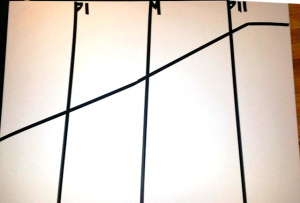It’s All A Plot
By Julie, putting away her summer clothes in Somerville
We’ve talked about being a pantser versus a plotter a few times on the blog. (Here, here, and here, for example.) Sherry Harris still talks about the expression on my face when she told me she wrote the end of her book before she wrote the middle. The Clock Shop Mystery series, which I am writing as Julianne Holmes, came with a book bible, which suited me fine. I not only enjoy a roadmap, I require one.
Because, dear friends, I am a plotter. And I’ve got a new toy, er…tool, to help me. Here it is.

Poster Board with dramatic structure guidelines.
I just submitted my first Clock Shop manuscript. I had broken it into scenes, and used Scrivener, but I didn’t pay enough attention to the dramatic structure. This affected the pacing, and the story telling, and got fixed in editing, but still. Yeesh. There had to be a better way for a plotter like me. I read Jessie’s post last week about her process, and was inspired by her use of post-its. I decided to steal the idea, but since I don’t have a blank wall, I bought some poster board, and created a visual image to help me put the scenes in the right places.
This is a combination of the structure The Weekend Novelist Writes a Mystery and the three act dramatic structure narrative I know from theater. A beginning, a middle, more of the middle, and an end. Rising action, climax, falling action. The timing of the inciting incident–the problem that starts the story. Plot points or act turns–moments in the novel that complicate the problem, or reverse the reader’s expectations. The end, when it all comes to a head. And the denouement, where the reader (or audience) can relax a bit, and loose threads are tied up.
I am currently writing scene descriptions on post-its. I am also writing other scene descriptions that probably won’t be in the book (they take place in the past), but they inform the story. And finally, I am describing a few scenes from a subplot I am starting in the first book, want to continue in this book, and conclude in the third book. Once I have finished writing out the scene descriptions, I am going to put them on the board. And I am going to make sure the act breaks (plot points) fall in the right place, and have scenes that turn the action.
Confused? Hour long dramas are a great way to think about dramatic structure. (Law and Order, for example.) What was the hook that drew you into watching? What happens at the fifteen minute mark? What keeps you watching? Were you surprised while watching it? If the story fell apart, when and why?
Any other dramatic structure fans (nerds?) out there? Any fellow plotters?
Filed under: Julie's posts




